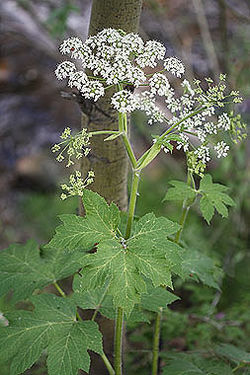Cow Parsnip
Other Names : Heracleum sphondylium, Common Hogweed
See also :
- Persian Hogweed
- Heracleum (Homeopathy)
Special Precautions of Cow Parsnip
Many members of this genus, including many of the sub-species in this species, contain furanocoumarins. These have carcinogenic, mutagenic and phototoxic properties. For example giant hogweed (H. mantegazzianum) contains phototoxic compounds particularly furanocoumarins (angelicin, psoralen, and so on) which cause unfavorable effects on skin health.
Health Benefits and Uses of Cow Parsnip
Heracleum species, also known as hogweed, are traditionally used as food additives, spices, and flavoring agents. Moreover, these plants are widely used in folklore medicine for the treatment of many disorders such as inflammation, flatulence, stomachache, epilepsy, psoriasis, and as carminative, wound healing, antiseptic, antidiarrheal, tonic, digestive, pain killer, analgesic, and anticonvulsant agents. The genus Heracleum has broad pharmacological activities: anti‐inflammatory, antimicrobial, anticholinesterase, anti‐oxidant, antiviral, cytotoxic, and anticarcinogenic.
- antihypertensive
- diarrhea
- dysentery
- sedative
- healing wounds
- stomachic
- digestive
- aphrodisiac
- menstrual problems
- dyspepsia
- Vasorelaxant : Senejoux and others (2013) investigated the vasorelaxant effect of dichloromethane extract of H. sphondylium on rat isolated thoracic aortic rings. According to this study, the plant exhibited vasorelaxant properties through an endothelium‐independent mechanism involving the inhibition of Ca2+ mobilization and changes in Kv channel conductance.
- Antimicrobial
- Anti‐oxidant
- Cancer : Maggi and others (2014) screened the essential oil of H. sphondylium subsp. ternatum against 4 human tumor cell lines: MDA‐MB 231 (human breast adenocarcinoma cell line), 7986 (human glioblastoma multiforme cell line), A375 (human malignant melanoma cell line), and HCT116 (human colon carcinoma cell line). The essential oil exhibited moderate cytotoxic effect only against A375 and HCT 116 cell lines. Again, the authors tested cytotoxic activity of 2 major components of the essential oil namely octyl acetate and octyl butyrate. Octyl butyrate exerted significant cytotoxic activity against A375 and HCT 116 cell lines. Thus, octyl butyrate appears to play a major role in the cytotoxic activity of the oil.
